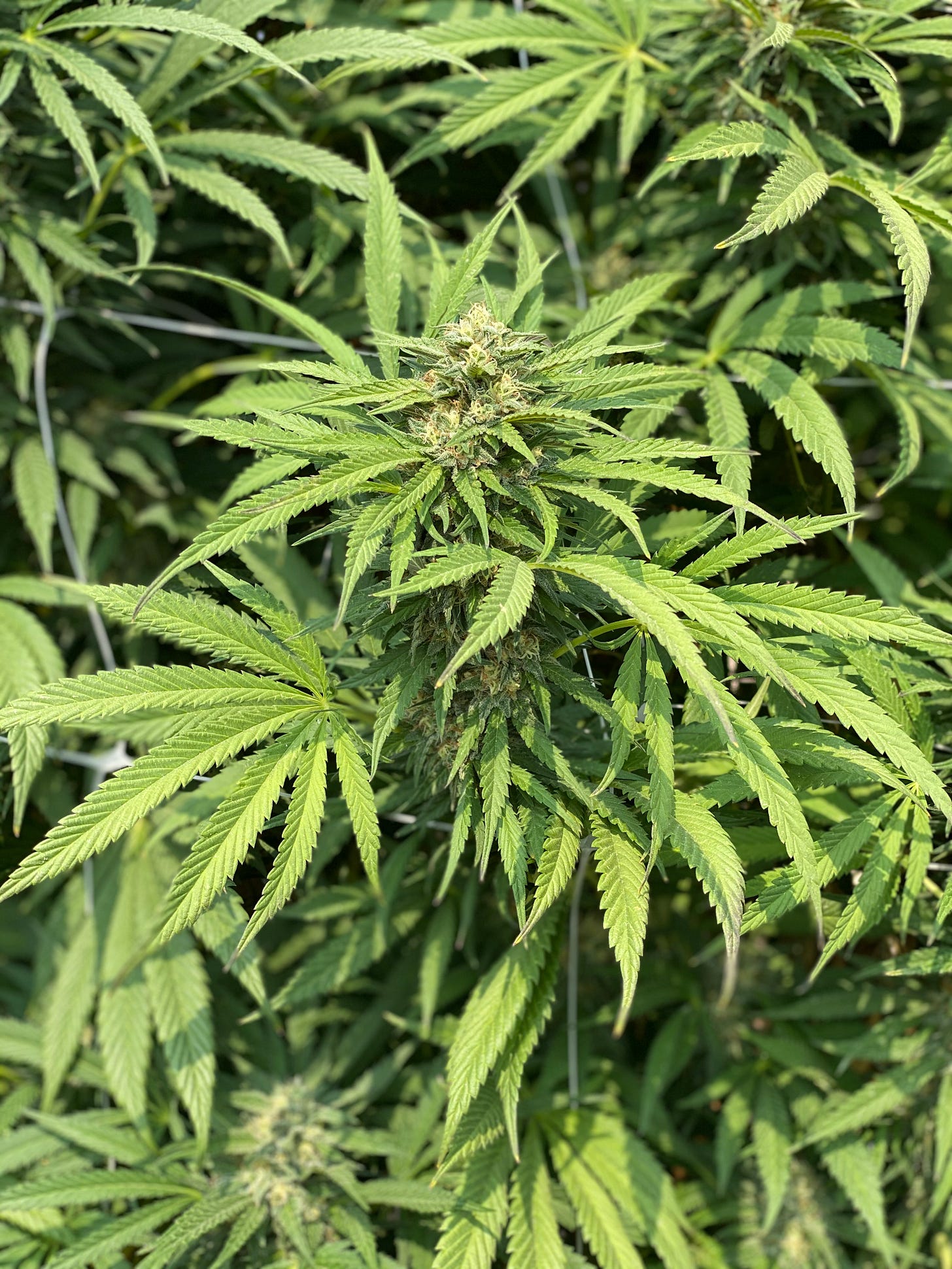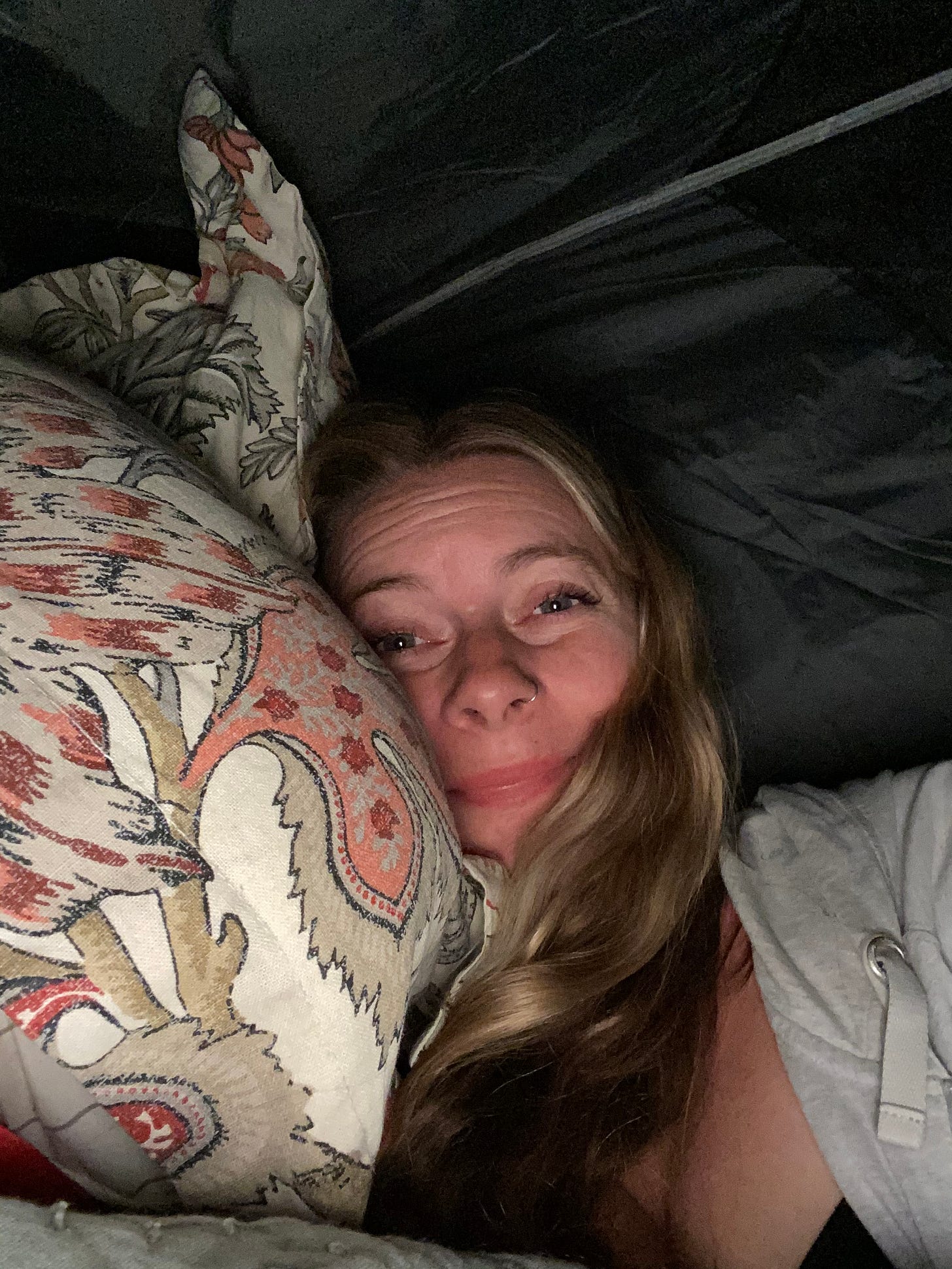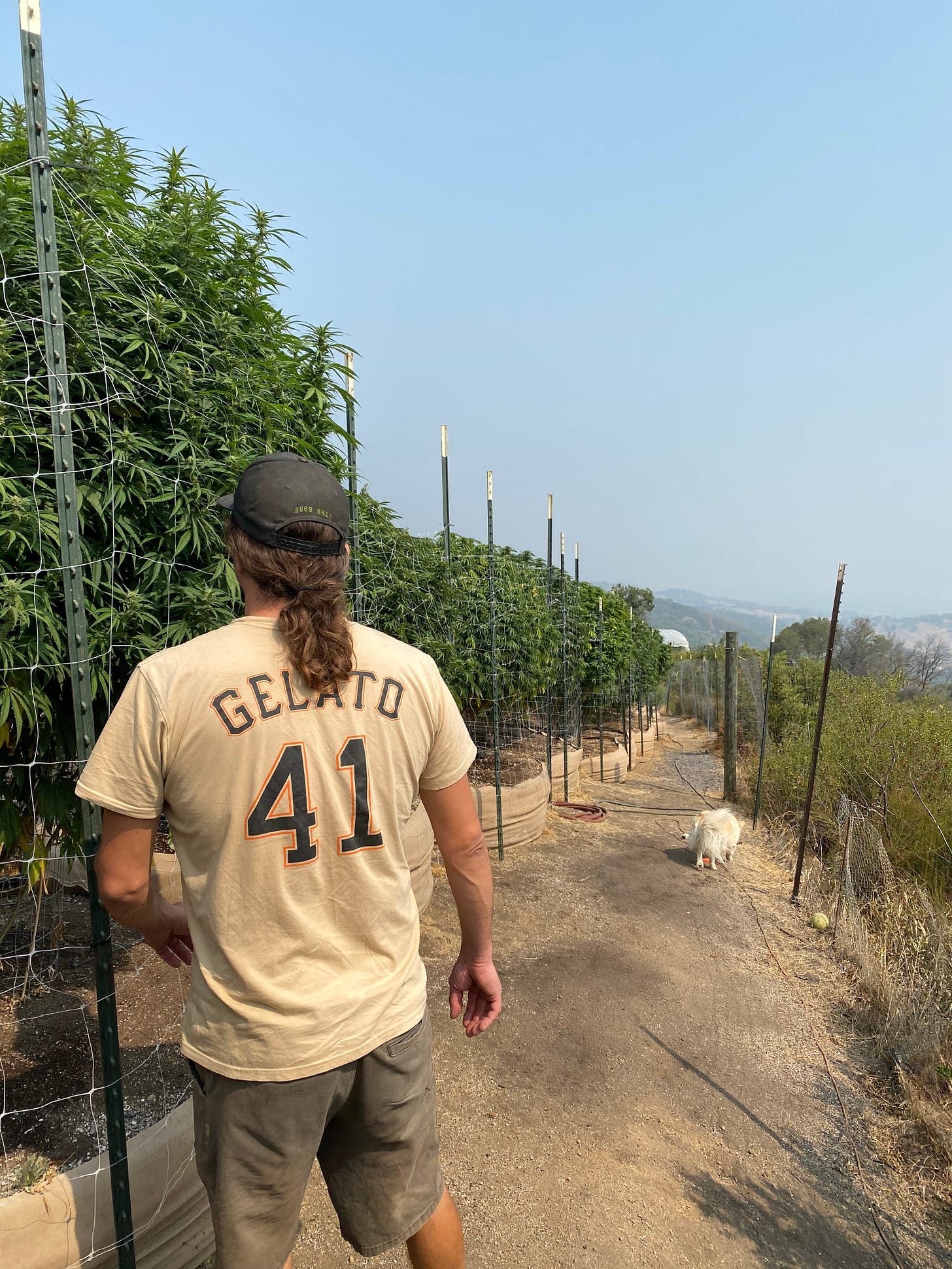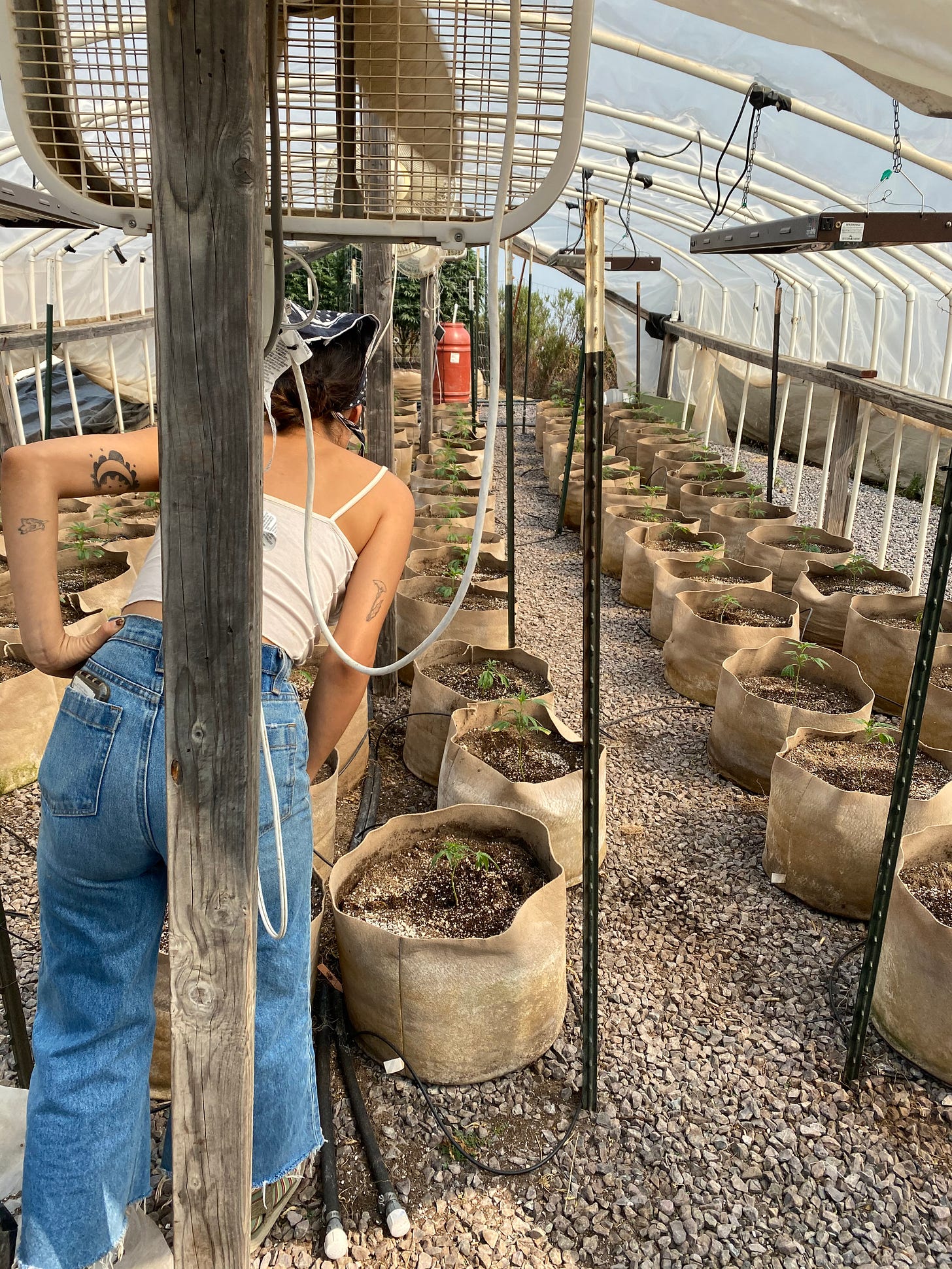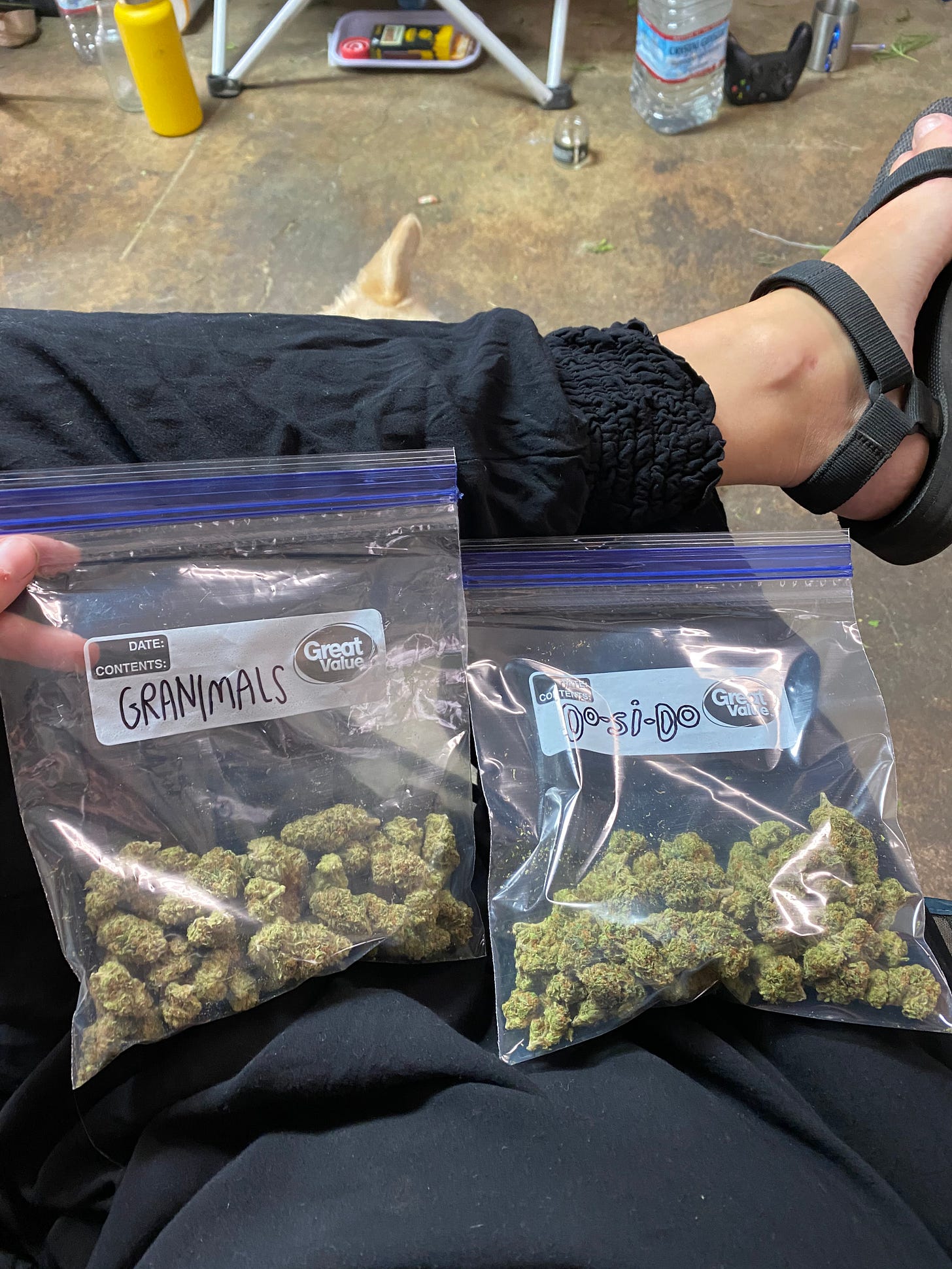California's weed country is lit
Fires ravage the historic home of American cannabis cultivation
One night I was coughing so hard I woke myself up. It was one of those dry, insidious coughs that started with a sinus tingle and ended with dry heaving once my body realized there was nothing more to expel. Then, moments later, it started again, only letting up until my eyes fully bugged out.
I had been in one of those sleeps that was so deep and disorienting that someone could have told me I was anywhere in the world at all and I would have believed them. I looked around, remembered I was in my tent, and pulled a jagged rock out from under my butt. I hacked again. “Fuck!” I said out loud to nobody.
Rather than waking up in a comforting place, I was instead in southern Mendocino County, camping on a semi-legal cannabis grow operation. Seeing as this was only a month or so ago, it also meant I was there during the August Complex fires, which are still burning and, as of this writing, 74% contained, despite recently converting to what’s now called a gigafire (that’s not a good thing).
Mendocino County is part of what’s called the Emerald Triangle. The name refers to the cannabis growing region in northern California that made up of three counties, officially—Mendocino, Humboldt, and Trinity—and others in its vicinity that are equally rural and therefore provide cover for a variety of less-than-legal operations, such as growing cannabis.
The Emerald Triangle is the historic home of cannabis cultivation in the present-day United States. It’s where most of the country’s black market weed comes from, no matter if it’s from a plug in San Diego or from “a guy” in New York. It’s where all the good bud that wasn’t Mexican brick weed has always come from. These days, plenty of legal cannabis is grown and sold there, too. I’m sure many reading have seen Murder Mountain, the documentary series that showed up on Netflix about two years ago? That takes place in the Emerald Triangle. It’s kinda the place, as far as weed is concerned.
So, it shouldn’t be surprising that I’ve found myself up there a lot in recent years. This year, in particular, I received invitations from farmers, legal and illegal alike, to see the cannabis harvest firsthand, which begins in September and continues throughout the rest of the year. Not to be, you know, whatever about it, but it’s a big deal to be invited! Even with legal grows, there are a lot of security concerns, so people can’t just show up and say, “Where the weed at?!” One must be asked to show face. If I’m honest, I’ve never even asked to visit. It always seemed like a narc move. At best, it was deeply uncool. I’ve always waited for the invite.
So, when I received some invites this past August, the origins of which spanned varying legalities, I knew I had to head north. At the same time, California’s wildfires began and quickly burned out of control, threatening not only the immediate areas I was due to visit but also the industry I make a living covering and partake in as a consumer. I sent a bunch of texts to my contacts all over the Triangle.
“How are you guys? Evacuation plans? Still harvesting? Still want me to come?” my messages read. I got enthusiastic “yes” responses from everyone.
“It’s really gnarly up here, but we are safe. We have a good evac plan. We will take care of you. Come see what we’re up against…ps have some fire for you to try,” one of the texts from a grower read. Imminent danger, a good story, a long road trip, cataclysmic earth happenings, and really killer weed? I couldn’t say no. I drove up one day in September, a straight 13-hour shot from my home in San Diego.
To turn an adage on its head and make it painfully literal: where there’s fire, there’s smoke. The smoke is what woke me up in my tent at 3 a.m. that night, despite the nearest blaze being about 20 miles away. I remember quietly saying out loud to myself, “You’re a fucking idiot, Jackie,” before readjusting my sleeping pad and blankets, coughing a few more times, lighting a joint because, truly, who cares anymore? and eventually flipping my zip-up hoodie backward. I fell back asleep with the hood over my face as a makeshift smoke shield, deciding that the risk of suffocating myself with my own hood was worth it for a decent night’s rest.
Camping on grows is required in many cases—often, because the work is temporary and sometimes illegal, it makes no sense for the owner and/or grower to build permanent structures on the land. Whatever permanent or semi-permanent structure that does pop up quickly turns into storage for clones, drying plants, and equipment.
Plus, a human presence is required near the plants at all times, especially near harvest, for security reasons. It’s a popular moneymaking pastime for the most hardcore of outlaws to rob grows of product and cash just before harvest, when plants are mature and ready to be cured and processed into the street product we all know and love. That’s why I was outside, sleeping alone in a secluded part of the property. Others on the grow staff bedded down elsewhere on-site—in a garage, their cars, or in their tents.
It’s been exceptionally hard on the farmworkers, who are spending months at a time on grows—much longer than the handful of nights I spent in the area. If they don’t work, they don’t get paid. If they bolt, they will most likely not be invited back to work for future harvests. There are always more bodies to take their places.
“The hill and farm have been covered in smoke for about a month,” Andrea A., a trimmer near Ukiah, in Mendocino County, tells me over text. “The smoke has literally BARELY lifted, we had to harvest in the smoke because of how urgent it was to save the plants,” she says.
“Because of [the smoke], some of the plants are dying,” Andrea says. “Browning at the stem or budding too early—like three weeks too early. Our farm was set to produce a good amount. The most they’ve ever produced,” she says.
Andrea’s boss, let’s call him Jake, who is the head grower in charge of the whole operation, confirmed this to me. “We were expecting to average around 5-7lbs [of saleable dried cannabis flower] per plant. Looking like it’s gonna be 1-3lb average,” he said to me over text. Jake noted that he has 99 plants, which meant they were expecting 500-700 pounds and will now only get 100-300. He believes the heavy, consistent smoke blocked out the light—something other growers have commented to me, which caused the plants to yield less overall.
This echoes what I’ve heard from other Triangle growers throughout the 2020 growing season. This was set to be a record year, many of them said. Now, faced with crop loss and taint, it’s poised to be one of the most devastating ever.
Every grower I talked to—10, in total—also knows a few people who have lost everything. Their farms completely burned. Most of these farms are, at best, only partially legal. In Mendocino County, in particular, it has become common for farms to become licensed only at the county level, stopping short of state oversight and licensing. County officials overlook the lack of state permitting, seeing as it’s not their jurisdiction, and tend to not see much incentive in blowing the whistle at the state level. They’re getting paid, so who cares?
It’s much cheaper for these small farms to stay illegal, thanks to the mountain of permitting fees, taxes, and expensive tweaks they’d have to make, like making the farm Americans with Disabilities Act compliant, which would require putting in bathrooms. I went to the bathroom in a hole in the ground the entire time I was there, among other mild inconvenient indignities for me that are prohibitive for many others. This is one effect of operating in the shadows. Needing to put up with smoke inhalation during working is another.
Another shadow effect is that if a farm isn’t legal, there aren’t many ways to be insured. Forget about federal disaster aid, too. Even if a farm is legal, that’s only at the state level. Cannabis, as a Schedule I narcotic, is still federally illegal. Major insurers won’t touch it with a ten-foot pole. Some cannabis insurance companies specifically cover cannabis operations, but there is only one I know of that covers outdoor growers, and I have been unable to confirm their efficacy.
Even the most legit of the legit—hemp, a federally legal cash crop—lacks access to insurance. In California, qualifying as a fire-safe property worthy of insurance is becoming increasingly elusive as everything seems to exist in a fire zone nowadays.
There isn’t really a silver lining here, save for the fact that cannabis is, blessedly, an annual crop. It will be a new year next year, regardless of what else happens between now and then. That’s a helpful reminder for us humans, too. The August Complex fires, which were tempered over the weekend by much-needed rain, are still burning as of today, October 12, 2020. The complex, which was ignited by a lightning strike, comprises 38 fires that have, so far, burned 979,386 acres. Many of the farms in that land were so off-the-grid that their losses won’t be publicly known, though they will be felt in the cannabis markets.
For those who like to jump ahead, your suspicions are correct: there will be a squeeze on supply, both legal and illegal, across the nation and local to California.
“2021, at least the first six months before greenhouse starts to flip, is going to be a really dry year,” says Julia Jacobson, CEO of Aster Farms, a licensed farm in Lake County that sits just over the Mendocino County line. “Many cultivators were not able to get their licenses renewed, now add the fires to it? We’re losing some of the best farms in California who are growing outdoors,” she says to me while we sit in the shadow of her flowering plants. Jacobson and her business partner and husband, Sam Ludwig, speak from experience. In 2018, Aster Farms lost a house and several structures during the Mendocino Complex fire.
One of the striking things about experiencing a disaster in real-time is that, for slower-burning ones, isn’t all panic and pain. There are moments of genuine levity, like the hug I received from Andrea after emerging from 13 hours in my car alone. There is the fat joint filled to the brim with Do-Si-Do that her co-trimmer, who I had never met before, rolled for me so it would be ready for my arrival. He even uses water, rather than spit, to seal it, to keep it Covid-safe. There are the conversations about the killer sushi joint in Ukiah, the garbanzo aguachile Andrea and her partner whipped up. There are the countless joints we individually take to the face as we all decide to press pause on the literal world on fire—during a pandemic!—that surround and threaten to consume us at the hint of a wind change. In a myriad of ways both big and small, we all decide to quietly push on.
“Just another speed bump in life,” Jake says to me over text just this morning. “You can only do what you can, and you can’t change the weather. We’ve replanted our greenhouses and gonna keep moving forward.”
If you enjoyed this Cannabitch, please share it! Please also consider paying to subscribe so I can keep them coming. Thank you for being here.






